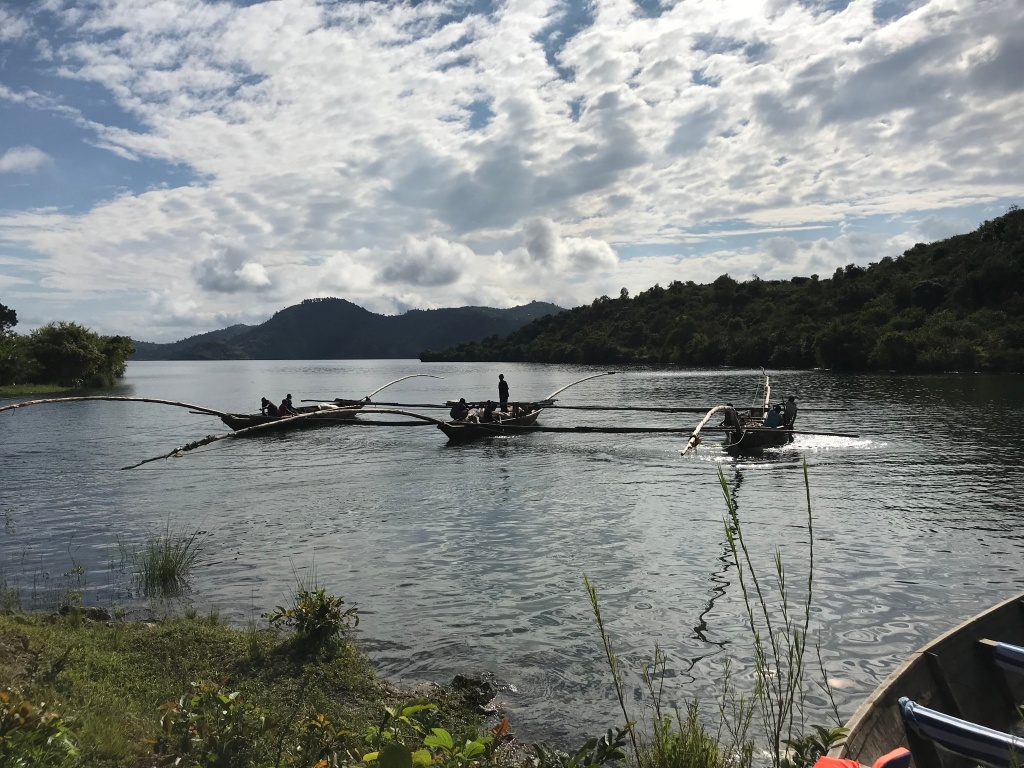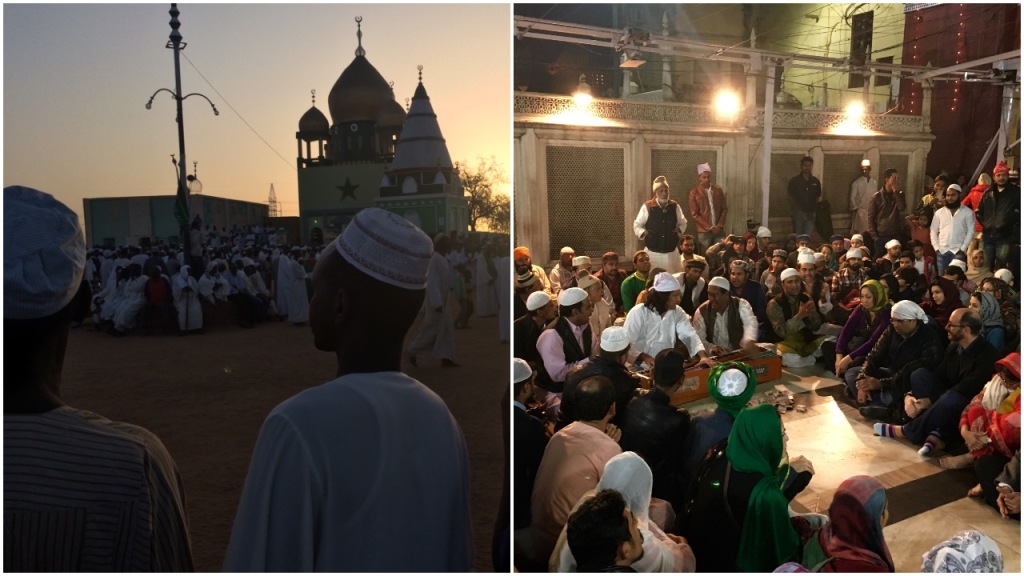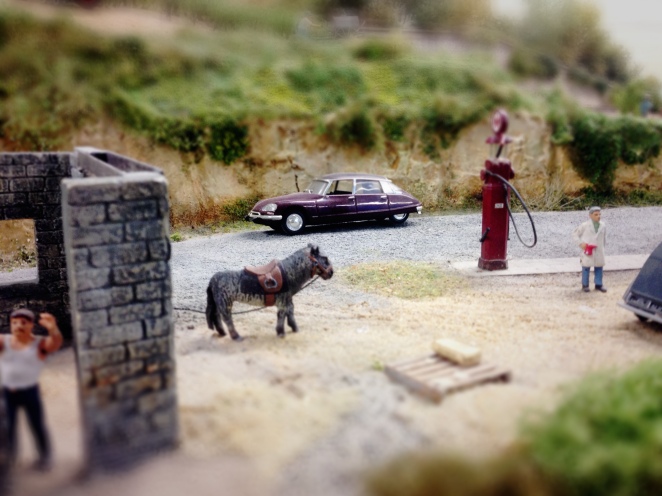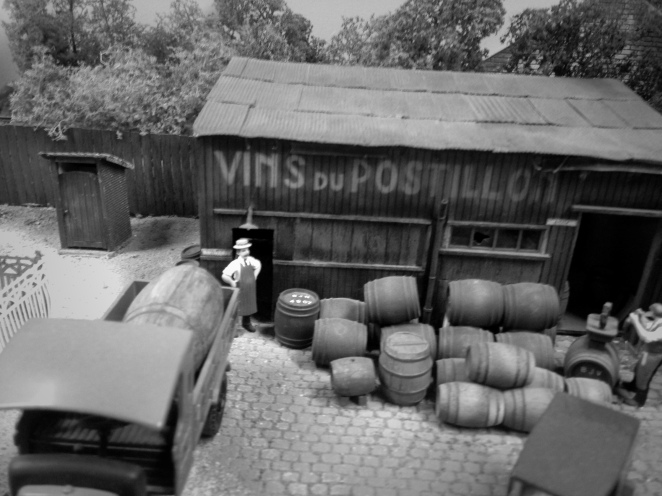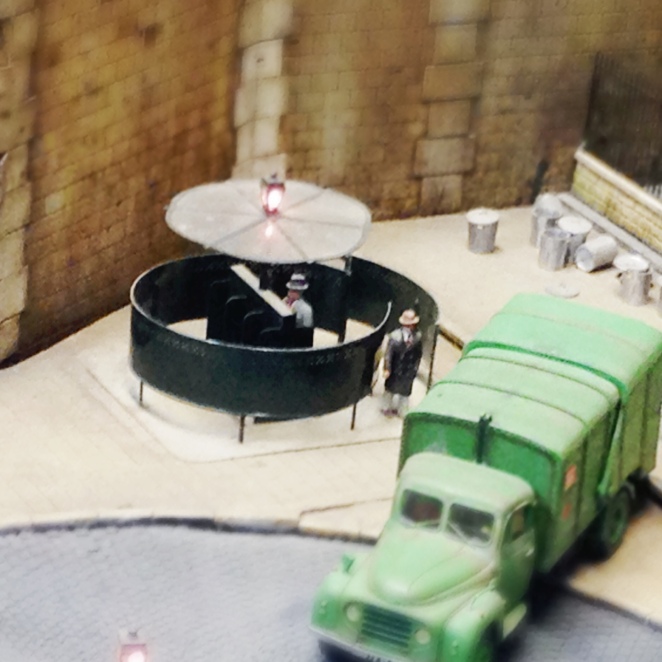We had the pleasure of meeting the famous singing fisherman of Lake Kivu in Rwanda, on their way back from a night of catching tiny sambaza fish. The fish are delightful fried and shared with friends with a few bottles of Primus beer, but nothing beats the synchronized harmonies of the singing fisherman of Lake Kivu. My tribute here:
A Tale of Two Dervishes – Sufi Music in Khartoum and Delhi
The capitals of Sudan and India are not often thought of as must-see tourist destinations. Delhi is all too often just an entry point for tourists visiting India. And Khartoum, well, Sudan’s capital is after all… in Sudan, which is not high on tourism bucket lists either.
People are missing out. Delhi is a delightfully insane patchwork of vibrant communities and leftovers of ancient empire(s) all stuffed together in a frenetic megacity. Khartoum is actually a peaceful and calm oasis on the Nile, with some of the friendliest human beings I have ever encountered. I’ve greatly enjoyed visiting and working in both cities over the past few years.
And interestingly enough, at the top of the to-do lists for visitors to both of these cities are very similar cultural attractions: Sufi shrines that feature the rhythmic devotional music so typical of this mystical branch of Islam.
A trip across the Nile from Khartoum to see the whirling dervishes of Omdurman is a must for the few visitors to this city. In Delhi, checking out the Thursday night Sufi Qawwali singing at Nizzamudin is one of the most unforgettable experiences that the city has to offer. I’ll let my video from December 2016 prove the point:
Although both sites attract some tourists, the vast majority of visitors are adherents of the Sufi branch of Islam. Unsurprisingly, there are a number of similarities between the Sufi two sites. Both are located at tombs of important Sufi leaders. The singing and dancing at both sites happens once a week, at sundown. And both sites serve a larger spiritual purpose for Sufis, making a visit to one a real, enriching experience.
Nizzamudin is located in posh South Delhi but stands out enormously from its surroundings. It is a tiny medieval village of shrines, mosques, mausoleums, kebab joints, and Islamic shops that has grown around the tomb of the 14th Century Sufi saint Hazrat Nizamuddin. Arguably the most important Indian Sufi saint, the Shaikh Nizzamudin believed in the power of mysticism and was a proponent of the power of music and poetry to move people closer to God.
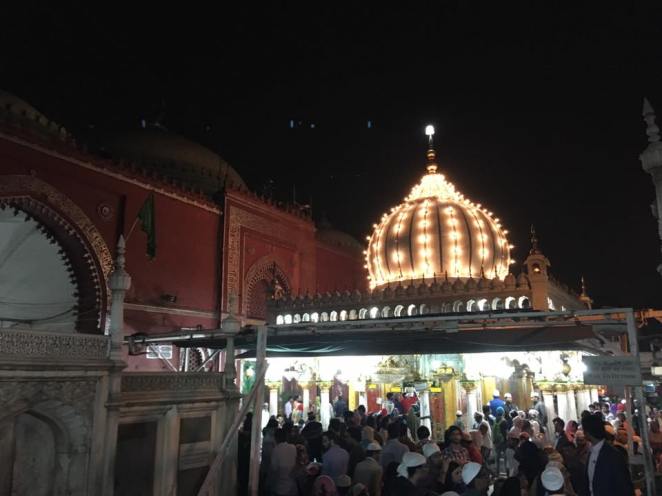
In front of the Shaikh’s tomb
Centuries later his followers are doing just that. Every Thursday huge crowds gather at the Shaikh’s tomb, navigating a series of alleyways and tightly packed streets to reach the shrine. The alleys get smaller and smaller as you get closer to the Dargah, Persian/Urdu for “Shrine.” Every inch is covered by vendors hawking rugs, Islamic goods, oils, and plates of flower offerings. Pilgrims crowd into a small courtyard in front of the shrine, eagerly awaiting the arrival of the Qawwali musicians.
Eager indeed: My first attempt at seeing music there was a bust- we waited over an hour before the musicians decided that they weren’t going to play. My second visit late last year was successful. The second I emerged from the labyrinth into the courtyard, I knew my ethnomusicologist heart wasn’t going to be broken again as the sounds of Qawwali drifted through the crowd.
Qawwali is practiced throughout South Asia, from Pakistan to Bangladesh. The late, great Nusrat Fateh Ali Khan from Pakistan popularized the style among Western audiences.
One of my favorite Qawwalis from the master, Sanu ik Pal Chain:
What really struck me at Nizzamuddin was the diversity of the audience – a perfect microcosm of India’s complex multi-faceted society. Sikhs, Hindus, Buddhists were all there to pay tribute to the Shaikh and take in the Qawwali. The songs were primarily in Punjab and according to my friends, some of the melodies were in fact popular Bollywood tunes with lyrics changed around. I noticed Sikhs praying right next to Muslims.. India really is incredible:

In Omdurman, Sudan, the ceremony takes places every Friday, outside the tomb of the 19th Century Sufi leader Sheikh Hamed al-Nil. The shrine is located inside a dusty cemetery on the outskirts of Omdurman, Sudan’s capital in the 19th century.
In fact, a few blocks from the cemetery lies another important tomb, that of the “the Mahdi,” Sudan’s mythic religious leader who fought against the colonial Egyptian and British forces in the 19th century. It’s relatively easy to visit this tomb and adjoining museum before seeing the dervishes, taking in a huge whiff of Sudan’s bloody colonial past: the Battle of Omdurman, General Gordon’s defeat, etc. etc.
Arriving at Sheikh Hamed al-Nil mosque is magical in itself. I tried to document it here:
Most of the visitors to the mosque are part of the Qadiriyya Sufi sect, followers of the Sheikh Hamed al-Nil. In stark contrast to the ubiquitous white jalabiya that many Sudanese men wear, the Sufi dervishes wear colorful green robes and sport long deadlocks.
And yes, they whirl. As the music increases in intensity the dervishes attain a higher spiritual level, going faster and faster. Adherents pulse back and forth around the dervishes chanting and playing on large frame drums. I noticed women and men dancing quite close to each other. The music was as rhythmic and pulsating as Qawwali, and was mostly in the distinct Sudanese pentatonic scale. I tried to capture some of the tunes:
Nizzamudin doesn’t have the same caliber of whirling dervishes, but many adherents go into a trance-like state during the Qawwali. Both times I visited, a group of young woman could be seen – and heard – flinging themselves back and forth behind a latticed screen in a corner of the courtyard almost like they were possessed.Their screams got louder and louder and by the end the few Western tourists were visibly disturbed.
But it was a sure sign of the real spiritual fervor that was going on, along with the great tunes. If you are looking for a real-deal 21st Century mystical experience with some fabulous music, go no further than Nizzamudin and Omdurman.
Le Carillion and Friday 13th Paris Attacks: An Ode to the Café Concert
Cafés and concerts were the principle target of the Friday 13th terrorist attacks in Paris so I thought it would be appropriate to offer a brief tribute to the “café concert.” There is something about the café concert that is so uniquely Parisian, and so emblematic of that little Bohemian chunk of the Right Bank that was targeted by the terrorists last week.
Pictured here are a few snaps from a run-of-the-mill café concert in 2009 at the Carillion in the 10th arrondissement. As millions around the world now know, the Carillion was one of the cafés attacked on Friday the 13th, with at least 12 deaths. One widely-circulated photo showed sheet-covered bodies in front of the bar’s distinctive red façade. I’d like to share some memories of the bar before the attacks.

My old time band the Ol Timey Messengers had a series of café-concerts there, playing Sunday afternoons for a motley crew of bar regulars and occasional “fans.” Like many Parisian bands, we had been searching for years for the perfect café , speaking with countless dive café owners throughout the 10th, 11th and 18th arrondissements. Our buddy Claire-Sophie introduced us to the Carillion and it seemed like a good fit. After all, organizing a café-concert in Paris can be wonderfully informal – often a brief conversation with a barman over a pastis can seal the deal. No press packets, references, demo CDs. Just a handshake.
Virginia fiddler and guitarist Thomas Bailey joined the band for some shows at the Carillion and his wife Mozell snapped these photos before succumbing to the bar’s potent “ti’ Punch,” a sticky rum-based cocktail from the Antilles.

At the time, the Carillion was still building up its hipster cred and had many traits of the classic neighborhood Paris dive café. Like many cafés in Paris, it was run by ethnic Berbers from the Kabyle region of Algeria. Bordering a number of working-class Parisian neighborhoods, the café had a diverse clientele of Arabs, Berbers, Chinese, Afro-Caribbean folks and all other sorts of permanently inebriated chain-smoking characters.
In other words, the perfect audience for Appalachian fiddle music and a few Elvis numbers care of infamous Paris-based English Rocker Brad Scott (pictured above on ukulele). Where else but in Northeast Paris could a group of American and English folk musicians serenade a bar of Chinese, Jewish and Arab shmata salesmen with obscure Kentucky fiddle tunes, Hawaiian ballads and sea shanties? That’s the Paris I love.
The café concert, like Parisians themselves, is a moody beast. Sometimes you are playing to room of people fully engrossed in their conversations, barely looking up to acknowledge the band. Clearly your music is disturbing their hushed conversations about politics, sex and film (in that order). Yet other times, you play to a café jam-packed with sweating drunken lunatics standing on bar stools, yee-hawing at every song. Other times you play to that perfect Paris music-going crowd of respectfully quiet chin-stroking intellectuals. Or sometimes your audience will consist of just one drunkenly waltzing couple, swaying majestically on the tiled floor.

Like so many good things in Paris, café-concerts are firmly rooted in the past. Starting in the 19th century as a form of light entertainment, the café-concert evolved into a truly egalitarian Paris pastime. Manet and others took a liking to the café-concert at the turn of the century. We all know what happened in the 20s and 30s. Café-concerts took a dive after World War Two but the 1980s saw a revival with, many rock and punk shows held in cafés in Belleville and other Northeastern Paris neighborhoods.
When I left Paris last year, the café-concert seemed to be going strong, although the ongoing economic crisis was taking a toll. Some of my best memories of the city were playing or attending café-concerts. Nothing beats walking down a cobblestone Paris street in the middle of night as the sounds of an accordion, fiddle, or manouche jazz guitar drift out of the one dimly lit café. Its damn cliché but I saw it thousands of times. Let’s hope it doesn’t stop.
Photos by Mozell Miley-Bailey
An afternoon with the legendary Trallaleri singers of Genoa
European polyphonic singing, an ancient vocal style featuring interweaving melody lines, can still be heard from the Mediterranean to the Caucuses. Interestingly, the wildest form of European polyphony is not found in an isolated Corsican village or deep in the mountains of Georgia but in the quiet alleys, piazzas and docks of Genoa, Italy’s busiest port.
This unique style is known as Trallalero, after the rhythmic nonsense syllables used by its mostly male singers. Alive and well in Genoa and the region of Liguria, Trallalero features up to twenty singers that preform in squadre (teams). Each squadre features an aural orchestra of weird and wonderful voices, from soaring falsettos to a chorus of booming basses.
I first heard Trallalero over 15 years ago through Alan Lomax’s legendary 1950s recordings in Italy. Lomax was dumfounded by the Trallaleri singers he discovered, claiming it was some of the most remarkable music he recorded in Europe. He described it as “music of the Genoese longshoremen.” One recording in particular, La Partenza, completely blew me away. It had a distinctly medieval feel, with the melodic complexity of a Bach fugue, the rhythmic drive of Balkan music, the ornamentation of a Renaissance opera and felt distinctly, well, Martian. I vowed to make it one day to Christopher Columbus’ hometown to hear the style live.
Finally, after ten years in France my wife and I decided to do a weekend away from the kids in Genoa. I got to work on some serious google ethnomusicological research before the trip. After many days, I found a few leads then set off to Tanzania for work.
Who would have thought that my first invite to a Trallalero session would land in my inbox one night in a hotel in remote Mbeya, Tanzania. I had finally made contact with Lucica, one of the few woman Trallalero singers, via a facebook page. After a long back and forth, she announced that her squadre would be having its last practice of the summer during our visit!
Fast-forward a couple of weeks to Genoa, the rendez-vous was in a completely unremarkable cafe off a small piazza in the old city. We showed up early, tired from a day wandering around the city’s labyrinthine alleys. The tiny cafe was packed with a somewhat rowdy group of septu- and octogenarians downing coffees and engaging in oh-so-Italian lively banter. Seemed like a normal scene.
After a few minutes, the men paid up at the bar and one by one filed up a minuscule staircase at the back of the café, continuing to banter and slap each other on the back as they ascended. Upstairs, tables were pushed to the sides and a tiny table was left in the middle with a bottle of red wine and plastic cups. The singers arranged themselves in a full circle around the table and quieted down.
The squadre began to sing (try headphones for full sound):
And so began my hour or so with the Trallaleri. It felt like a real, honest practice: The group sang about 12 tunes and had ample time to yell at each other (“it’s a Ligurian thing, Lucica assued me”), discuss arrangements and drink. The squadre, called “I Raccögieti,” is one of about five active teams in Genoa proper. A brief explanation on how it all works:
Each squadre has very specific voices that play specialized roles. First, there is a triumvirate of melody voices. In the above video, the gentleman in the yellowish polo shirt, Mario Olivieri, is the tenor or the primo voice. Next to him, the baritone, which sings counterpoint to the tenor. Then there is the contralto, above in a striped shirt – an amazing singer named Stefano Ardigò Contraetu. The contralto sings in a highly-stylized falsetto voice. Everything is done in the distinct Genoese dialect.
On the other side, a full choir of basses, directed by a lead bass. Then, the really odd addition: the chitarra, or “guitar” – the man in the video, towards the back, with a hand over his mouth.
Women are a rarity in this music, so we were especially lucky to catch one of the few female singers of this style, Lucica, taking over the role of tenor:
There seems to be a good deal of debate about the origin of the music. Some whom I spoke with disagreed about Lomax’s theory of longshoremen origins. According to Stefano, the music started in bars in the 19th century, mixing religious music with popular Opera and Ligurian folk traditions. Clearly the port did bring in outside influences and it seems they show up in the music – the droning bass recalls Greek Orthodox chants (or other Eastern vocal styles). Just check it out (another recording without video but with better audio):
Genoa was recently the subject of an urban makeover. The city’s infamous port was scrubbed clean(er) and great effort was taken to attract tourists to this once-seedy town. These days Genoa is stunning. Stately avenues lined with 19th century buildings dot the hills over the city, offering vertiginous views over the Ligurian Sea. The old port is cleaned up and the piazzas burst with life. A massive, modern aquarium on the harbor recalls Boston or Baltimore, rather than a salty longshoremen’s den.
According to Stefano, this gentrification has started to push Trallalero outside of the city, deeper into the mountains behind Genoa. He says that Trallalero is now alive and well in small villages, but interest in dying out in the city. The chance that you’ll run into some Trallalero harmonizing in piazza on a typical tourist jaunt are low. A funny irony: a folk music that is quintessentially urban in nature is now moving to a more rural setting. An almost opposite effect than what we’ve seen with countless other folk traditions that start rural but ended up widely practiced in cities.
I’ll end this post with a particularly poignant number, “E Americhe.” It’s the story of an immigrant to America – fitting for Genoa’s history and fitting for my upcoming return to the shores of E Americhe.
2014 Paris Street Food Festival
When I first moved to Paris 10 years ago, street food basically consisted of (i) rancid kebabs – I remember a local newspaper tested 100 randomly-chosen kebabs in a lab and 50 of them had traces of fecal matter (ii) ghastly crepes filled with rotten cheese that leaked engine-fluid like grease that literally burnt through clothes (iii) Incinerated “chestnuts.” Parisians definitely didn’t take kindly to having a bite on the street: They found it uncouth and seemed especially unhappy to burn through their fashionable outfits with nuclear crepe grease.
Like so many parts of the Parisian culinary scene, things have changed… big time. The first food trucks appeared in 2009, spearheaded by the now famous hamburger van Le Camion qui Fume. It was a rough start, with all sorts of permit issues and tussles with the authorities. A few years later, food trucks were popping up all around the city serving burgers, tacos etc. to the Hipsteratii of Paris. Now they are an institution. “Street food festivals” are being held around the city and an insane amount of new trucks – some distinctly Francophile and other completely Brooklynified – are showing up on street corners around the city.
I checked out the “Festival de la Street Food” [actual name] this weekend. A few snaps:
The festival was held at the temple to Paris Hipsterdom – the newly-renovated Carreau de Temple. Food trucks were parked in front (and inside) of the massive 19th-century cast iron structure. The lines of hipsters were 100+ deep only a few hours into the festival.
Tacos and other “consumables” (cupcakes, burgers, bagels, beer) have been a mainstay of the new Paris “Broukligne” culinary scene. So it only makes sense that taco trucks would materialize. This one – El Tacot – was our favorite truck at the festival. No-nonsense tacos, fresh, good value, quick service.
Australians!
Inside the Carreau de Temple – overpriced but nice dumplings.
Yup, a “New York Deli” style food truck with mutant bagels. Must be the water here….
Bretons checking out a bride. I didn’t try their crepes but they looked distinctly non-nuclear.
The rare “Gallic” participant.
Honey and waffle cones! Cultivated on the roof of the Carreau!!
Fish and chips! It’s a strange world..
Keep in mind that only a few years ago, there were very few vegetarian options in Paris. It was a struggle to entertain visiting Americans. Now you can get veggie hot dogs on the street. Times are a-changing.
Bastille Day 2014: Seven things that you should know about France, en petite taille
I took my sons to the excellent Model Railroad Museum in Rambouillet forest outside of Paris this weekend and realized that the gargantuan railroad and miniature exhibition offered some telling lessons about France. I snapped a few photos that illustrate perfectly what I learned about France.. after 10 years living here!
Here’s my listicle:
 Welcome to France! It’s reeeaal purty here.
Welcome to France! It’s reeeaal purty here.
We like the countryside, livestock and the hydropneumatic suspension that allows us to drive across fields without breaking a single egg in a basket (according to legend, this was a direct order to Citroën’s engineers from President de Gaulle).
wine
We like fresh fish.
And we invented quality of life!
Happy Bastille Day! More posts coming soon…
Chechamba – Portrait of a Malawian Old Timey Musician
I was in Malawi recently for work and I had the great pleasure to meet Wenham Chechamba in Blantyre, the country’s second-biggest city. Still going strong at 80 years old, Chechamba is a multi-instrumentalist, composer, sought-after music teacher and somewhat of a beloved national treasure.
I used scrollkit to create a little multimedia website on Chechamba, with videos, photos and interviews of the man himself. Click here or the photo and scroll away!
Syrian Refugees
 Have a look at a new project I was involved in (on top of my full-time job and twin baby boys, hence the lack of posts). Along with the European University Institute and French newspaper Liberation, we’ve created a single-issue news website on the situation of Syrian refugees in neighboring countries.
Have a look at a new project I was involved in (on top of my full-time job and twin baby boys, hence the lack of posts). Along with the European University Institute and French newspaper Liberation, we’ve created a single-issue news website on the situation of Syrian refugees in neighboring countries.
Interactive timelines, data visualization, multimedia, on-the-ground reporting: lots of fun stuff! Have a look and stay tuned for my blogging on the gangs of Paris:
New Media for a Forgotten Massacre
The killing of up to 200 Algerian protestors in Paris by police on October 17th, 1951 has been called France’s “forgotten massacre.” Exactly fifty years later, it seems light is finally being cast on the events of that cold autumn night –with a distinctly new media flair.
At the height of the Algeria’s war of independence, thousands of Algerians gathered in Paris to protest a curfew imposed by the city’s police chief Maurice Papon (yeah, that Maurice Papon). The Algerian National Liberation Front (FLN) had called for a demonstration against what they considered a racist curfew imposed solely on the capital’s Algerian residents. Up to 30,000 peaceful protestors filled the streets. But most historians believe that Papon had planned in advance for a violent crackdown against the demonstrators. Throughout the night, over 10,000 protestors were beaten, arrested and then sent to detention centers in series of attacks throughout Paris. Anywhere from 50 to 200 protestors were beaten to death or shot dead by police.
Most horrifyingly, dozens of dead or unconscious protestors were thrown into the Seine. Bodies were found downstream, some as far as Le Havre, 100 miles away on the English Channel.
Until recently, the events have been little covered by the mainstream press and still are not included in school textbooks. In fact, many French historians and commentators claim that the government has covered up the killings. The government has yet to officially apologize and authorities still question the death toll.
This year marked a real turning point, with plenty of coverage of commemoration events in the print media and a deluge of new books. Moreover, the French talent for multimedia web production was on full display, with an impressive amount of content available online. After all, the French love the web documentaries, which they lovingly call webdocs (every self-respecting bobo is “finishing up their webdoc”). Webdocs are a perfect meeting ground for the French love of photo, video and quirky storytelling.
Here’s a quick round-up of what I’ve found online this week:
La nuit oubliée (The Forgotten Night)
A fantastic webdoc combining comics, video interviews and much more. There’s also a great interactive map of Paris. Click below for the webdoc (french only):
17.10.61
Another webdoc, with interactive map and plenty of interviews. The trailer is below and you can find the webdoc here: (also only in French)
Intro 17.10.61 from Cosmografik on Vimeo.
Owni
The youngins over at Owni are Paris’s own data visualization gods, widely worshiped in new media circles. They featured a great visualization (below) and an article with scans of official documents showing that French authorities planned out the illegal incarceration of thousands of “FMA,” or French Muslim Algerians:
Ici on noie les Algériens (We drown Algerians here)
The French talent for documentaries has also been poorly applied to the events of October 17, 2011 – up until now, very few films have been produced about the massacre in the center of Paris. Seems this is changing as well. Here’s a trailer for one that opened in select Paris theaters yesterday:
The Godfather Comes to Montreuil?
A violent attack on a squat in the eastern suburbs of Paris last weekend has received a considerable amount of media attention for what has become an almost banal Parisian summer event: squatter evictions.
Over the weekend around twenty masked strongmen wielding iron bars and tear gas lay siege to a group of “activist” squatters in an abandoned house in the municipality of Montreuil. What the press has called an “armed raiding party” smashed the building’s entrance gate on Saturday, roughed up some inhabitants and returned two times over the weekend to wreck more havoc. According to witnesses, police showed up 30 minutes after the attack started but did nothing to stop the casseurs (hooligans). One usually reads about staged battles between casseurs and the police – this was a weird turn of events.
In a series of short statements released to indymedia, the squatter “collective” said they had occupied the house since 2007 with no outside ownership claims. Despite calling the squat La Maison qui Pue, (the House that Stinks), the collective insists that they lived in harmony with their neighbors. According to the collective, this weekend’s attackers were hired by a local real estate group called IAD that professes to have bought the house and wants to avoid a lengthy legal battle.
There was a surprising amount of mainstream buzz this week. Even the mayor of Montreuil chimed in, condemning the raid to the AFP. Local politician and teacher Bruno Saunier wrote an editorial piece on the website of news channel France 24 describing the owner’s “mafia-like methods.” The attack has received a large amount of coverage, including center-right Le Figaro, thanks to a video taken by a resident of the neighborhood:
But evictions at the numerous squats in the Eastern Paris suburb of Montreuil are an old story – squats have been sprouting up in this famously far-left neighborhood for decades, bringing in artists and anarchists alike. French law forbids evicting tenants during the winter, so the warmer months see a number of evictions, especially in Montreuil. It’s somewhat of a spring fertility rite in the area. Whole streets are blocked off for massive police operations, as screaming anarchists are dragged out of the large and often charming turn-of-the-century houses typical of Montreuil. The squatters have an impressive support network and always manage to attract local attention to their cause, while shunning the mainstream media.
This weekend’s event was different. It almost seemed that French press sniffed a whiff of the Godfather in the air. The media buzz has had an effect: According to Bruno Saunier’s personal blog, the two employees of the real estate company that ordered the attack have already been fired.
Squatters versus casseurs versus the police versus squatters. The gangs of paris never cease to amaze me.
